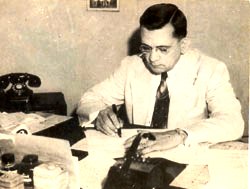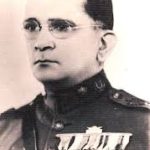On August 22, 1922 the musician and veteran of the army liberator Luis Casas Romero, with his son Luis Casas Rodríguez, put to air the first radio station that broadcast from Cuban soil: the 2LC, date taken as birth of the radio in Cuba.
This plant, with a power of 10 watts in your signal, transmitted in the 360 meter band and was the first to give the time and the weather forecast. Some sources say that houses Romero, a noted musician, opened transmission of every day playing diana mambisa front microphone.
Also recorded in the annals of the radio in Cuba, who was also a composer of anthological musical pieces, pulled the microphone out of the window he came out to the roar of the traditional cannon shot of the nine air.
The 2LC was officially inaugurated on April 16, 1923. It was gradually expanding its power to 100 watts and its programming, live, two-hour originally was increasing up to six.
The truth is that in 1920, the creator of the musical genre called Creole, had made running a plant amateur radio five watts, identified by the acronym Q2LC, which radiated in the 75 to 150 meters band.
On March 9, 1927 was authorized to the houses to get air COC, Shortwave broadcaster, commercial, although the license was not issued until December 16, 1933. After changing owner twice, that plant would become the coconut-CMCK, the newspaper of the air.
Luis Casas Romero, flutist and composer of emblematic musical themes, was born in the year of 1882 in Camagüey.
In 1891 he began to study music, and two years later joined the Popular society Orchestra Santa Cecilia. In 1901 he joined the Board of Trustees of the children’s music band.
In 1904 he moved to Havana, where he served as flutist and conductor of the teatro Martí. He later traveled to Mexico as the conductor of the company of Raúl de el Monte and in 1907 he settled definitely in the Cuban capital, where he worked regularly as a pied piper of the Orchestra that maestro Jorge Anckermann directed at the Alhambra theatre.
In 1908 was a member of the Sextet that performed at the teatro Martí and led the Orchestra of the Neptune. In 1909 he was appointed Professor of flute of the National Conservatory of music, institution which then has taught music theory, theory of music, harmony, composition and band and Orchestra instruments.
Composer: Luis Casas Romero.
In 1913 he joined the army of the Republic as flutist of the band of the staff of the camp of Columbia and in 1918 became the Deputy Director of the orchestral Association, which later led until his death, on October 30, 1950. He also became artistic director of the radio station belonging to the Cuban Telephone Company CMC.
Recognized as enshrined radio amateurs, although experts are not in agreement on who was the first person in our nation who dabbled in this science-art, Luis Casas Romero and his son are arguably sown in the history of the Cuban radio that this August 22 turns 94 years.
Agencies/Rad.Coco/Gilberto Gonzalez / extracts/Internet Photos / Arnoldo Varona / TheCubanHistory.com
THE CUBAN HISTORY, HOLLYWOOD.
FOLLOW US ON TWITTER AND FACEBOOK. THECUBANHISTORY.COM
LUIS CASAS ROMERO, PIONERO DE LA RADIO CUBANA. (Nacido en Camaguey).
El 22 de agosto de 1922 el músico y veterano del Ejército Libertador Luis Casas Romero, junto a su hijo Luis Casas Rodríguez, pusieron al aire la primera emisora de radio que transmitió desde suelo cubano: la 2LC, fecha que se toma como nacimiento de la radio en Cuba.
Esta planta, con una potencia de 10 watts en su señal, transmitía en la banda de 360 metros y fue la primera en dar la hora y el parte meteorológico. Algunas fuentes aseguran que Casas Romero, un destacado músico, abría la transmisión de cada día tocando la diana mambisa frente al micrófono.
También se recoge en los anales de la radio en Cuba que, quien además fue compositor de antológicas piezas musicales, sacaba el micrófono por la ventana para que saliera al aire el estruendo del tradicional cañonazo de las nueve.
La 2LC se inauguró oficialmente 16 de abril de 1923. Paulatinamente fue ampliando su potencia hasta llegar a 100 watts y su programación, en vivo, de dos horas originalmente se fue incrementando hasta seis.
Lo cierto es que ya en 1920, el creador del género musical denominado criolla, había puesto en funcionamiento una planta de radioaficionado de cinco watts identificada por las siglas Q2LC, que radiaba en la banda de 75 a 150 metros.
El 9 de marzo de 1927 autorizaron a los Casas para sacar al aire la COC, emisora de onda corta, de carácter comercial, aunque la licencia no se expidió hasta el 16 de diciembre de 1933. Después de cambiar dos veces de dueño, esa planta se convertiría en la COCO-CMCK, El Periódico del Aire.
Luis Casas Romero, flautista y compositor de emblemáticos temas musicales, nació en el año de 1882 en Camagüey.
En 1891 comenzó a estudiar música y dos años más tarde se integró a la orquesta de la Sociedad Popular Santa Cecilia. En 1901 se sumó al Patronato de la Banda de Música Infantil.
En 1904 se trasladó a La Habana, donde fungió como flautista y director de orquesta del teatro Martí. Más tarde viajó a México como director de la orquesta de la compañía de Raúl del Monte y en 1907 se radicó definitivamente en la capital cubana, donde trabajó regularmente como flautista de la orquesta que dirigía el maestro Jorge Anckermann en el teatro Alhambra.
En 1908 era miembro del sexteto que actuaba en el teatro Martí y dirigía la orquesta del Neptuno. En 1909 fue nombrado profesor de flauta del Conservatorio Nacional de Música, institución en la que después impartió clases de solfeo, teoría de la música, armonía, composición e instrumentos de banda y orquesta.
Composicion de Luis Casas Romero.
En 1913 ingresó al Ejército de la República como flautista de la banda del Estado Mayor del campamento de Columbia y ya en 1918 pasó a ser subdirector de esa agrupación orquestal, la que dirigió más tarde hasta su fallecimiento, el 30 de octubre de 1950. También llegó a ser director artístico de la emisora CMC perteneciente a la Cuban Telephone Company.
Reconocidos como consagrados radioaficionados, aunque los expertos no se ponen de acuerdo en quién fue la primera persona en nuestra nación que incursionó en esta ciencia-arte, Luis Casas Romero y su hijo están sembrados indiscutiblemente en la historia de la radio cubana que este 22 de agosto cumple su aniversario 94.
Agencies/Rad.Coco/Gilberto González/ Extractos/Internet Photos/ Arnoldo Varona/ TheCubanHistory.com
THE CUBAN HISTORY, HOLLYWOOD.









